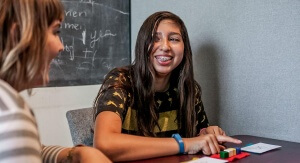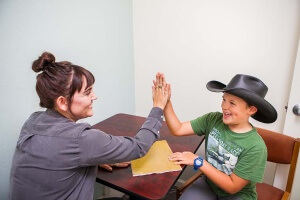The term “positive reinforcement” pops up frequently in discussions about education. Yet, not everyone knows what this actually sounds like when used effectively. We’re proud of the way we’ve carefully built verbal positive reinforcement language into our lessons as part of our student-centered approach to learning, and we’d like to share our secret to success with you!
What is verbal positive reinforcement? 
Positive reinforcement is the use of a reward immediately following a desired behavior, which increases the subject’s desire to reproduce that behavior—for example, earning a bonus for performance at work, or immediate feedback on something done well. In verbal positive reinforcement, the reward is spoken praise—for example, saying “thank you for using nice words when you speak to me,” after a child asks nicely for something, rather than the child demanding what they wanted.
How to use it
Positive reinforcement works best when used very specifically, as in the example above, and when it’s given directly after the desired behavior (waiting decreases the link between the desired behavior and the reward). Thanking your child for “being good” the day after they said “please” will not cause them to say “please” more often!
Why do we like it?
Not only is positive reinforcement proven to be more effective than many other training methods, it also helps our students feel good about themselves—it keeps the emphasis on their successes and strengths, rather than on errors. This also helps them to focus on the process of learning, rather than giving a correct response. Additionally, we feel good about ourselves as educators, knowing we have helped our students build positive behaviors that also increase their confidence and curiosity.
What do we reinforce the most?
We particularly like to emphasize positive behaviors during sessions, rather than giving praise for getting everything “right.” We might thank a student for using the steps we have taught her to outline an essay or for not giving up when a task gets difficult. We want to ensure our students know it’s OK to make errors—everyone does it!—what matters is that they try, work hard, and use the tools we teach them.
How to use verbal positive reinforcement when handling errors
During our rigorous training, we make sure tutors learn how to handle errors in a positive way. Therefore, rather than taking a red pen and crossing out errors or telling a student he is “wrong,” we complement that student on what he is doing right, then ask if he can “double-check” the rest for us.
What’s does this sound like in practice?

In this example, the tutor emphasizes the things the student did well, which makes the errors seem less intimidating or negative. Additionally, the tutor empowers the student to correct her own errors, rather than correcting her externally. The tutor then reinforces the importance of using taught strategies with specific positive reinforcement, further encouraging the student to use those strategies in the future.

Use it at home!
Verbal positive reinforcement is a simple but very effective way to help students learn while establishing a good rapport and helping them stay motivated. It’s something parents can use to get the most out of reading at home with their kids. Of course, it’s not limited to reading and writing—you can use verbal positive reinforcement in any situation in which you want to increase a desired behavior (even when trying to get your partner to take out the trash!).
At the Literacy and Language Center Inc. we work with students using a student-centered approach and positive language reinforcement that augments our multisensory programs. We create a customized program for each student to meet their unique needs in addition to addressing academic weaknesses while honoring the student’s strengths. Give us a call at 415-242-1205 if you’d like to know more about our services.




Recent Comments